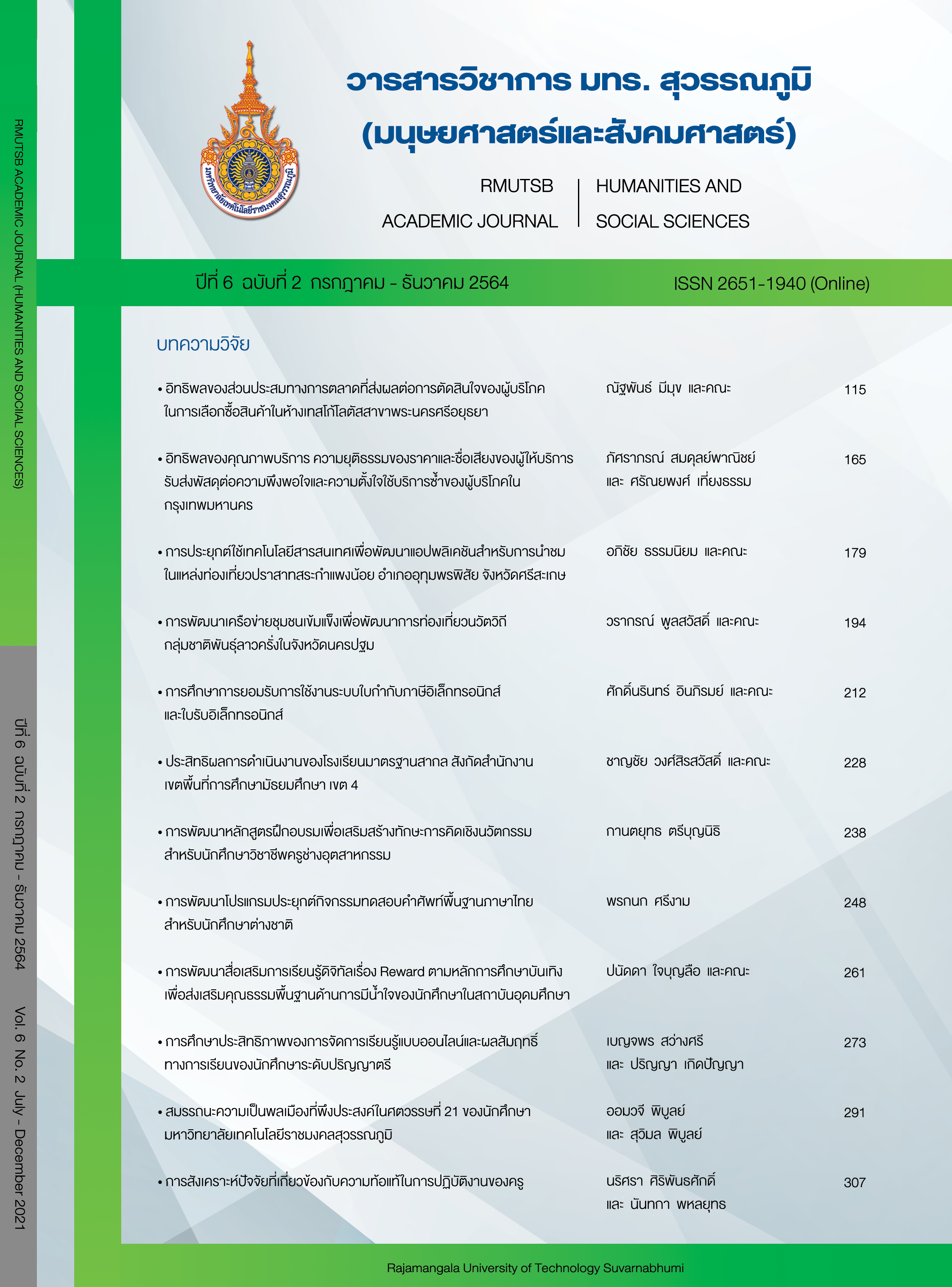การพัฒนาโปรแกรมประยุกต์กิจกรรมทดสอบคำศัพท์พื้นฐานภาษาไทยสำหรับนักศึกษาต่างชาติ
Main Article Content
บทคัดย่อ
การทดสอบความรู้คำศัพท์พื้นฐานภาษาไทยจะช่วยให้ผู้สอนทราบว่านักศึกษาต่างชาติมีคำศัพท์พื้นฐานภาษาไทยเพียงพอที่จะใช้สื่อสารเรื่องราวต่าง ๆ ได้หรือไม่ รวมถึงเป็นข้อมูลในการจัดการเรียนการสอนอย่างไรให้เหมาะสม การวิจัยนี้จึงมีวัตถุประสงค์เพื่อออกแบบและหาประสิทธิภาพของโปรแกรมประยุกต์กิจกรรมทดสอบคำศัพท์พื้นฐานภาษาไทยสำหรับนักศึกษาต่างชาติ กลุ่มตัวอย่างเป็นนักศึกษาต่างชาติที่กำลังศึกษาในภาคเรียนที่ 2 ปีการศึกษา 2562 มหาวิทยาลัยราชภัฏนครปฐม จำนวน 60 คน ผลการออกแบบเนื้อหาโดยอาศัยหลักการออกแบบการเรียนรู้และพัฒนาสื่อมัลติมีเดียของ ADDIE model ได้โปรแกรมประยุกต์มีลักษณะเป็นกิจกรรมทดสอบทั้งหมด 5 ชุด ชุดละ 20 ข้อ รวม 100 ข้อ ได้แก่ ชุดที่ 1 ด้านการวัดความสัมพันธ์ของเสียงพูดกับรูปภาพ ชุดที่ 2 ด้านการวัดความสัมพันธ์ของภาพกับคำหรือกลุ่มคำ (วลี) ชุดที่ 3 ด้านการแยกความเหมือน ชุดที่ 4 ด้านการแยกความแตกต่าง และชุดที่ 5 ด้านการวัดความเข้าใจความหมายของประโยค ผลการตรวจสอบประสิทธิภาพโดยผู้เชี่ยวชาญมีค่าดัชนีความตรงตามเนื้อหา (CVI) ครั้งแรกเท่ากับ 0.90 และครั้งที่สองเท่ากับ 0.96 ค่าความเชื่อมั่น (test-retest) เท่ากับ 0.82 ความเหมาะสม 4 ด้าน ได้แก่ ด้านออกแบบโปรแกรมประยุกต์ ด้านเนื้อหา ด้านการดำเนินกิจกรรม และด้านภาพรวม พบว่ามีความเหมาะสมระดับมากที่สุด ผลการทดลองใช้พบว่าคะแนนหลังเรียนสูงกว่าคะแนนก่อนเรียนอย่างมีนัยสำคัญทางสถิติที่ระดับ 0.01 โปรแกรมประยุกต์กิจกรรมทดสอบคำศัพท์พื้นฐานภาษาไทยสำหรับนักศึกษาต่างชาติจึงเหมาะสมที่จะใช้เป็นเครื่องมือสำหรับทดสอบวัดวงความรู้คำศัพท์พื้นฐานภาษาไทย และพัฒนาเป็นเครื่องมือที่ได้มาตรฐานเพื่อประโยชน์ต่อผู้เรียน ผู้สอน และหน่วยงานการศึกษาที่มีการจัดการเรียนการสอนภาษาไทยในฐานะภาษาต่างประเทศ
Article Details
เอกสารอ้างอิง
Cook, V. (2016). Second language learning and language teaching. New York, NY: Routledge.
Damrongkiattisak, W., Archaphet, N., & Chamnankha, D. (2014). Learning achievement between using print media and interactive multimedia of primary and secondary schools students. Academic Journal of Humanities and Social Sciences, Burapha University, 22(38), 135-156. (in Thai)
Haenjohn, J. (2015). Brain & emotions: A miracle connection. Ratchaphruek Journal, 13(3), 9-19. (in Thai)
Jawaut, N., & Chinokul, S. (2020). The Development of vocabulary learning model based on the cognitive theory of multimedia learning (VCML). Journal of Humanities, Naresuan University, 17(2), 27-48. (in Thai)
Kaewkaen, P. (2012). Attention process and the modified knowledge for cognitive science research. Research Methodology & Cognitive Science, 10(1), 1-10.
Kupongsak, N. (2012). Problems of using Thai language of foreign students: A case study of Chinese students at Bangkok University. Ramkhamhaeng University Journal Humanities Edition, 31(1), 123-139. (in Thai)
McMillan, J. H., & Schumacher, S. (2014). Research in education: Evidence-based inquiry (7th ed.). Harlow: Pearson Education.
Munsegvit, S. (2011). Evaluation in Thai language. Bangkok: Kasetsart University. (in Thai)
Phechtburi, N., & Punkhoom, W. (2017). Thai language teaching in Cambodia. RMUTSB Academic Journal (Humanities and Social Sciences), 2(1), 57-68. (in Thai)
Plaengsorn, R. (2008). Basic lexicon for beginning learners of Thai (research report). Bangkok: Srinakharinwirot University. (in Thai)
Plaengsorn, R. (2018). The principle of managing teaching and learning the Thai language as a foreign language. Journal of Education, 19(2), 1-13. (in Thai)
Rakmanee, S. (2011). Development of the knowledgebase on Thai as a foreign language. Bangkok: Kasetsart University. (in Thai)
Siriphan, R. (2018). Techniques for developing Chinese skills for beginners. Princess of Naradhiwas University Journal of Humanities and Social Sciences, 5(1), 103-112. (in Thai)
Somnam, S., Srivaddhanapong, J., Jearasumpus, S., & Yan, N. (2009). Learning characteristics and strategies learning the language of Chinese students studying Thai as a foreign language at the Institute of Higher Education, Northern Region Upper. Journal of FEU Acadamic Review, 2(2), 80-87. (in Thai)
Wiboolyasarin, W. (2014). A Web-based instructional design principle based on ADDIE model to teach fundamental Thai conversation for foreigners. Srinakharinwirot Research and Development Journal (Humanities and Social Sciences), 6(12), 192-205. (in Thai)
Yookuan, W., Wanprapha, T., & Hoksuwan, P. (2017). The development of computer assisted instruction (CAI) with the basic English vocabulary for daily life of Pratomsuksa 1 (Grade 1) students in Banhinwua School, Ranong province. RMUTSB Academic Journal (Humanities and Social Sciences), 2(2), 158-167. (in Thai)


